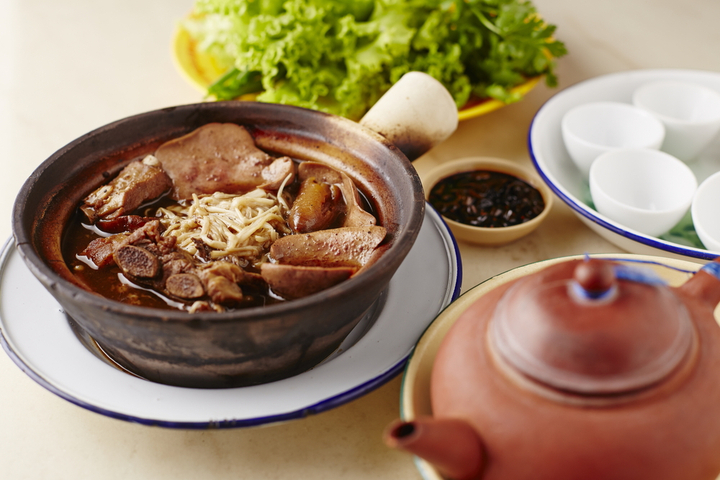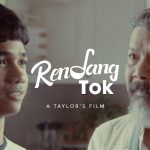Edward Ong is on a quest to discover and create Malaysia’s best ideas. He is an award-winning Writer and Creative Director and can be found at IdeasAreBorderless.com

Is Bak Kut Teh Chinese, Malaysian or Singaporean? In 2009, then Tourism Minister Ng Yen Yen famously declared that Bak Kut Teh is a Malaysian dish. As people born and bred in the same land, it is our national obligation to agree with her.
Bak Kut Teh (BKT) is a pork rib dish cooked in broth. In Hokkien, the name literally means Meat Bone Tea. Additional ingredients may include intestines (also from the pig), mushrooms, vegetables and steamed, dried or fried tofu. There is no tea in the broth. Tea is usually served in an accompanying teapot should you decide to order it.
There are three main types of BKT. Hokkien style has a dark soup, Teochew style uses more pepper while Cantonese has more medicinal herbs.
There’s also dry BKT, vegetarian BKT and a halal version with chicken instead of pork, called Chi Kut Teh. That said, somebody needs to hurry up and reinvent this dish- seeing as how nasi lemak is already being served in cups, and as cakes, burgers, fine dining, ice cream, pizza, sushi and soon on pancakes.
The origin of BKT is about as clear as its broth. Some say it was introduced by coolies working at Port Swettenham (now Port Klang). Others say it was brought in by a man from Fujian named Lee Boon Teh. It was originally called Bak Kut but because nobody but Lee could make it the way it should be made, they called it Bak Kut Teh (Teh being Mr. Lee’s last name).
And of course, there are hecklers who claim that their grandfather or some such spotted the dish being served in Clarke Quay, Singapore in the 1920s. They therefore posited that BKT was already in the vicinity somewhere between 1860 to 1920, several decades before its supposed arrival in Port Klang.
Perhaps we should ignore these troublemakers and stick to the version we like best. After all, Marketing Magazine has always been admired for its hard-nosed, no holds barred, investigative journalism, and we have a reputation to maintain!
The following is purely for academic discussion. It may or may not have happened the way it’s described. Since this column is about how Malaysia’s best ideas are created, I’ve put it in the usual template for the benefit of the two people who have been loyally following this series.
OBJECTIVE
Carrying heavy loads up and down the ramps is back-breaking work. Nonetheless, for the budding entrepreneur, this presents a few opportunities. One could A) Find a cheaper, more efficient way to transport the load, B) Help the coolies lighten the load or C) Offer some form of relief for their aching muscles.
CHALLENGE
A) is a technology problem. B) is also a technology problem since child labour is illegal and hiring more coolies is out of the question. The problem is therefore C). All marketing begins with correctly identifying the problem. How you define a problem will determine how you solve it.
TRUTH
In Klang, the Hokkiens can be traced back to the southern Fujian province, particularly the cities of Quanzhou, Xiamen and Zhangzhou. Hokkiens make up the largest sub-ethnic group among the ethnic Chinese arrivals. In traditional Chinese medicine, pork “moisturises dryness by nourishing yin”. And if you didn’t already know, pork is an indispensable part of meat eating in Chinese culture.
ANSWER
The solution is therefore something porky, preferably something familiar to Fujian taste buds. It helps also that the Chinese believe that eating part of meat close to the bones might help strengthen bone and joint health. BKT seems like a no-brainer. When it was introduced, I’m guessing the dish was an easy sell to hungry labourers.

On a final note, the shop that Lee Boon Teh opened is still operating in Klang to this date. Kedai Makanan Teck Teh is located at Jalan Stesen 1, Klang. And no, this isn’t a sponsored post.

Is the Customer at the heart of your Digital Transformation?
On 19th of July, MARKETING will be organising a conference on Customer-Centric Digital Transformation (#DTCX2018) to help you answer that question. The conference will be driven by Paul Stewart who authored the best-seller ‘Branded Customer Service’ and currently is the Special Advisor, Strategy & Transformation for TMI Malaysia. Drawing from his 25 years of diverse experience as a Chief Economist, CEO and consulting in organisational change, transformation and innovation Paul will be sharing his learnings and current trends in this realm.
He will be joined by key thought leaders in the areas of transformation, data analytics, customer service, branding, marketing, digital, human resources and more! Some of the key names who will be joining us include:
* Imran Kunalan Abdullah, Advisor/Principal Consultant – Digital Talent Development & Leadership and People Analytics
* George Aveling, CEO, TMI Malaysia
* Laurence Smith, Head, Asia Region, SmartUP
* Falko Leonhardt, Principal Consultant Transformation Strategy and Change, TMI
* Mohd Adam Wee Abdullah, Group CMO & Chief Customer Experience Officer, CIMB Group
and MORE!
Get ready to be inspired by case studies on transformation, honest conversations on driving change and actionable insights you can take back to implement in your organisation.
Date: 19th July 2018
Time: 8.30 am -6.00 pm
Venue: Sime Darby Convention Center, Bukit Kiara
For more information on DTCX 2018 contact Amira today at [email protected] or Book your spot early to avoid disappointment!
MARKETING Magazine is not responsible for the content of external sites.









